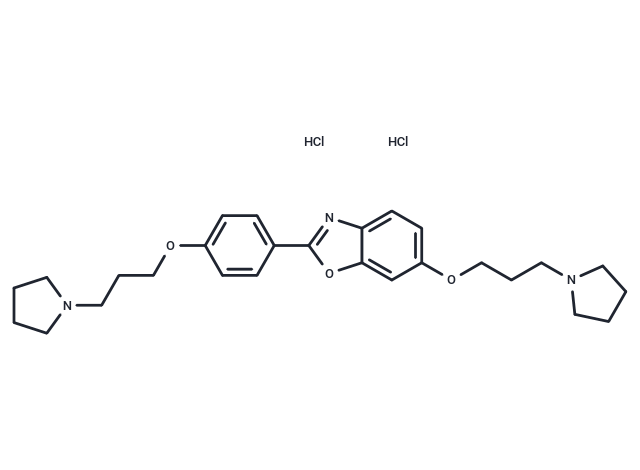Shopping Cart
- Remove All
 Your shopping cart is currently empty
Your shopping cart is currently empty

E6446 dihydrochloride is a novel synthetic antagonist for nucleic acid-sensing TLRs; potently suppressed DNA stimulation of HEK:TLR9 cells with IC50 of 10 nM.

| Pack Size | Price | Availability | Quantity |
|---|---|---|---|
| 1 mg | $109 | In Stock | |
| 2 mg | $161 | In Stock | |
| 5 mg | $321 | In Stock | |
| 10 mg | $396 | In Stock | |
| 25 mg | $662 | In Stock | |
| 50 mg | $943 | In Stock | |
| 100 mg | $1,280 | In Stock |
| Description | E6446 dihydrochloride is a novel synthetic antagonist for nucleic acid-sensing TLRs; potently suppressed DNA stimulation of HEK:TLR9 cells with IC50 of 10 nM. |
| Targets&IC50 | TLR9:10 nM. |
| In vitro | E6446 potently inhibited IL-6 production induced by CpG2216 but was ineffective against induction by the TLR3 ligand poly inosine-cytosine. E6446 showed a modest but consistent superiority over AT791, and both were significantly more potent than hydroxychloroquine. Significantly, 250 nM and 1.25 μM E6446 completely suppressed all of the CpG oligo-induced changes in gene expression [1]. E6446 specifically inhibited TLR9 activation with CpG ODN 2006, in the range of 0.01–0.03 μM. A 100-fold higher concentration (2–8 μM) of E6446 was required to inhibit TLR7/8 activated by the imidazoquinoline compound R848 [2]. |
| In vivo | To test their activity in vivo, mice were orally dosed with 20 mg/kg of AT791 or E6446 and 18 hours later were challenged with 60 μg CpG1668 oligonucleotide injected subcutaneously. CpG1668-induced IL-6 production was inhibited ~50% by AT791 and almost completely by E6446 [1]. therapy with E6446 diminished the activation of TLR9 and prevented the exacerbated cytokine response observed during acute Plasmodium infection [2]. |
| Molecular Weight | 522.51 |
| Formula | C27H37Cl2N3O3 |
| Cas No. | 1345675-25-3 |
| Smiles | Cl.Cl.C(COc1ccc(cc1)-c1nc2ccc(OCCCN3CCCC3)cc2o1)CN1CCCC1 |
| Relative Density. | no data available |
| Storage | Powder: -20°C for 3 years | In solvent: -80°C for 1 year | Shipping with blue ice. | ||||||||||||||||||||
| Solubility Information | DMSO: 5.22 mg/mL (10 mM), Sonication is recommended. | ||||||||||||||||||||
Solution Preparation Table | |||||||||||||||||||||
DMSO
| |||||||||||||||||||||

Copyright © 2015-2025 TargetMol Chemicals Inc. All Rights Reserved.